Alaska Fish & Wildlife News
July 2025
Swallow Tales
The plight of aerial insectivores
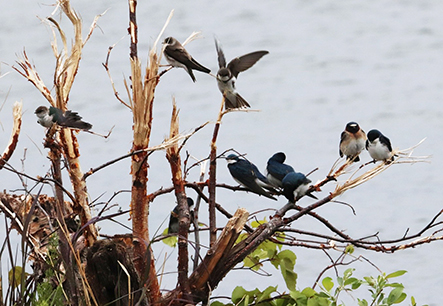
I’d never seen a Bank Swallow in Anchorage before this summer. Tree Swallows are the most visible of the Southcentral swallow species, as anyone who visits Potter Marsh can tell you, but this June I witnessed an unusual flocking of swallows in the city. I was at the Lake Hood seaplane base and a windstorm was sending a huge murmuration of swallows spiraling over the floatplanes. Though silhouetted and hard to see, I caught at least one forked tail out of the corner of my eye - a Barn Swallow? Then a group landed on a bush nearby and I identified Tree Swallows and a Violet-green Swallow, but also a Cliff Swallow, and a pair of Bank Swallows! I’d heard a lot about Bank Swallows from my coworkers running a swallow project in Fairbanks, but I had never actually seen a Bank Swallow in Anchorage. They are tiny compared to the other species, and recognizable by the necklace across their pale chests.
These small insect-eating birds are not doing well across the continent and their numbers are down, but at least for that afternoon, there were hundreds of the small birds over the water.
The Plight of the Swallow
Swallows, along with Flycatchers and Nightjars (or Swifts) are all birds that hunt by catching insects in flight, giving them the title of aerial insectivores. These small birds are characterized by fast and precise flight. The plight of these aerodynamic birds is shared by all bird species in North America - large population declines documented since 1970. There have been some 3 billion birds lost from the collective north American population in the last few decades, with aerial insectivores, in particular, declining by 32%, or 160 million birds. The Bank Swallow is also the focus of an ongoing Fish and Game study by the Threatened, Endangered, and Diversity (TED) Program in interior Alaska. These little birds, the smallest swallow in North America, have undergone an 89% decline since 1970 and a 98% decline in Canada, where they are listed as threatened.
How to identify Alaska’s swallows
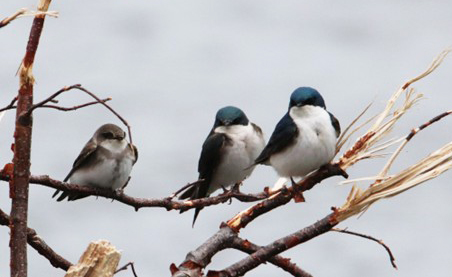
There are five species of swallow that you’re likely to see in Alaska, the Tree Swallow, Violet-green Swallow, Cliff Swallow, Barn Swallow, and Bank Swallow. Tree Swallows can be easily spotted around Potter Marsh in Anchorage and Creamer’s Field in Fairbanks. They can be seen all the way to the Seward Peninsula and have even been spotted at Round Island in Bristol Bay. They are characterized by a jewel-blue head and back that shines in the sunlight with a white chin and chest and dark wings. Violet-green Swallows are similar in size but sport emerald backs with purple rumps. In flight, a main identification tip between these two often overlapping species is to look for the white saddlebags and cheeks of the Violet-green Swallow. Cliff Swallows are darker than both these species, with red chins, cream rumps and necklace, and a bright white forehead, almost like a headlamp. The Barn Swallow is more southernly than these three species, found more often in southeast Alaska, with a red chin and forehead, cinnamon breast, dark back, and a longer, more sharply forked tail.
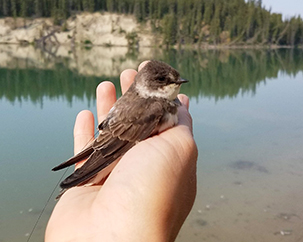
The Bank Swallow is less colorful than its fellow swallow species, with a dusty brown back, head, and an easily identifiable necklace across its white chest. When flying amongst other swallows, they can be difficult to tell apart, and sometimes their call can be the best way to identify them. Bank Swallows have a low buzzing call, almost like an electrical current going through high power transmission lines, a chattering tschr tschr tschr tschr. Bank Swallows are one of the few passerines (perching birds) that can be found on all continents except Australia and Antarctica. They are called Sand Martins in Europe and are also known as Collared Sand Martins, or Common Sand Martins.
The Bank Swallow
The scientific name of the Bank Swallow is Riparia riparia, meaning streamside, an accurate name for a bird that nests in banks and bluffs alongside rivers and streams (though some populations take up residence in sand and gravel quarries, and roadsides in Alaska). Unlike the more solitary Barn Swallow, Bank, Tree, Violet-Green, and Cliff Swallows all live in large colonies; with Tree, Violet-green, and Bank Swallows being cavity nesters. Bank Swallows dig little burrows into their sandy riverbanks and create a great honeycomb wall filled with tiny birds and nests. “Communal life seems a pleasant thing to these Swallows, and there is usually a considerable stir of activity about the quarter,” describes William Dawson in his 1923 account of the Bank Swallow colonies, which can range from 10 to 2,000 active nests.
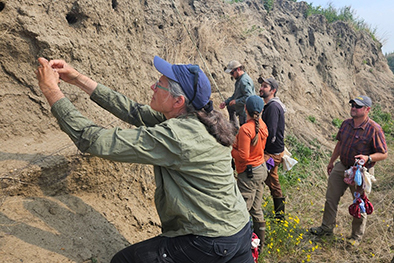
Bank Swallows forage in open areas and avoid tree cover. Almost their entire diet consists of flying insects like flies, wasps, ants, and beetles. Watching Bank Swallows hunting can be an amazing sight. Fish and Game’s TED biologist Eva Allaby describes watching a flock swirling low over the water in Fairbanks, hunting mayflies, and how the birds flew so close she felt she could “just grab them with [her] hands.”
To build their colonies, Bank Swallow males spend 4-5 days digging burrows into their sandy riverbanks using their beak, wings, and feet (their nails are longer than other Swallow species for this reason). Once done, the males will advertise the 6-inch deep burrow to females who will sometimes spend 3 days building nests inside using moss and feathers. They will lay 2-3 eggs (4 in Alaska) and incubate them for 2 weeks before hatching.
The Bank Swallow Project
Why are these small Swallows suffering such steep declines in North America? Is their mortality occurring on their non-breeding grounds? If so, where? And what is causing this?
When answering these questions, one of the first things to do is find out where the birds are going and track their migratory route when they leave Alaska. So, Eva Allaby and Julie Hagelin of ADF&G’s TED Program put GPS tags on birds in Fairbanks, a tricky task given the small size of the birds. VHF (very high frequency) technology was deployed for Bank Swallows, with 0.32 g tiny tags that can fit a 13 g bird. These tags emit a radio signal as the bird flies, which can be detected with hand-held antennas, or with special radio towers once they start migrating. These towers are a part of the Motus Wildlife Tracking System established in 2012, and pick up any and all species with VHF tags. There are hundreds of towers strategically located throughout the Western Hemisphere. When Bank Swallows fly into the range of a tower, the TED team gets the GPS point of the tower and the time the bird flew by. The bird has to be 0.3-9 miles away from a tower to be located. There is an active MOTUS tower in Anchorage, and several around Cordova tracking shorebirds, with more towers being added every year.
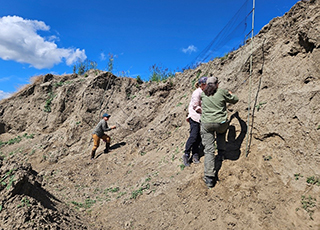
The Bank Swallow project is ongoing and still logging results from the migrating Bank Swallows. The goal is to compare the migratory tracks of different swallow populations to see what the declining populations have in common. So far, 890 tags have been deployed across 13 sites with 99 tags in Alaska. Along with USFWS, ADF&G captured and released 100 birds in Fairbanks, and built two small radio towers to monitor colony movements and feeding patterns. So far, out of the 99 Alaskan tags, 48 have been detected outside of the state, and 65 have shown clear migration departure dates. The data so far shows Fairbanks swallows beginning their migration to the southeast in mid-July.
Tracking Bank Swallow colonies is also a part of the ongoing project. Burrows can be seen in embarkments on the Chena, Tanana, and Chatanika rivers, as well as along roads in Fairbanks. Reach out to Dr. Julie Hagelin at julie.hagelin@alaska.edu if you have found any new Bank Swallow colonies so we can track their numbers and locations.
How to conserve aerial insectivores
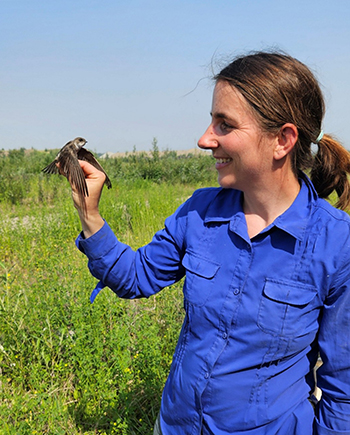
Luckily there are many ways that we can help conserve aerial insectivores in North America! To protect the birds’ food supply of insects, you can reduce pesticide use, support organic, and plant native gardens. Taking steps to prevent window collisions is particularly helpful as an estimated one billion birds are killed each year by window collision. Keeping cats inside can also protect cats and keep birds safe as outdoor cats kill up to two billion birds in North America every year. The last step is birdwatching, by watching birds and sharing what you see with sites like eBird, citizens can help scientists track bird populations and movements.
Subscribe to be notified about new issues
Receive a monthly notice about new issues and articles.
